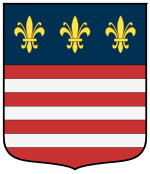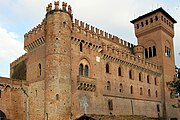Durazzo (noble family)
The Durazzo were an important family of the Republic of Genoa during the Renaissance and Baroque periods .
history
The first recorded member of the family was a Giorgio da Durazzo , who had fled the Albanian Durrës ( Italian Durazzo ) and was registered in Genoa in 1389. The port city of Durazzo had belonged to the Kingdom of Naples since 1271 (with interruptions from 1318 to 1365) . In October 1388 the Ottomans , who already controlled the surrounding area, launched a new attack on the city, and in February 1389 a Venetian contingent came to the embattled city to aid troops. Giorgio was enslaved by a Genoese while on the run in Messina and was brought to Genoa.
The family established itself there and soon made wealth through trade and silk processing . After four generations, Giovanni Durazzo, who held some public offices, was accepted into the patriciate of the Republic of Genoa in 1528 (in the so-called Albergo dei Nobili , the association of leading families). His son Giacomo (1503–1579) was elected the first of nine Genoese doges in the family in 1573 (the Doges of Genoa held office for only two years from 1528). The election of Giacomo came about because after the death of the ruler Andrea Doria in 1560, the rival "old" and "new" patrician families had agreed on an alternating occupation of the office of head of state and in 1573 it was the turn of a "new" candidate "Old" families could live; Giacomo Durazzo was considered a moderate representative of the "new" families and was therefore chosen as a compromise candidate.
The family maintained particularly close contacts with the old Genoese patrician family of the Grimaldi and sought to manifest their importance in numerous palace and villa buildings in and around Genoa. Until the 18th century, the family rose to the closest circle of the Genoese oligarchy. In 1622, Agostino Durazzo received the Gabiano Castle from Duke Ferdinando Gonzaga to settle debts ; from then on he and his descendants carried the title “ Margrave of Gabiano” . The castle remained in the family's possession until the 19th century and is still owned by their heirs, the Marchesi Cattaneo Adorno.
Some of the members appointed to the clergy to preserve the family fortune became bishops and two cardinals in their hometown. The Durazzo were committed to image cultivation in the social field and for the arts, so they founded a college for the training of impoverished nobles, put on an extensive collection of prints and promoted the theater.
In 1677 the Durazzo bought their Palazzo, later the Palazzo Reale, from the Balbi family as their residence and converted it into an impressive ensemble with a garden and theater; In 1823 they sold it to the Royal House of Savoy , which made it their residence in Genoa. The Doge Cesare Durazzo built the Palazzo Durazzo-Cattaneo Adorno in 1664 in Via del Campo in the Genoese old town; the palace remained in the family until the 19th century and is still owned by the heirs of the Cattaneo Adorno family. The Villa Durazzo in Santa Margherita Ligure was built as a summer residence in 1678 ; In 1821 it came to the dignified Genoese patrician family Centurione and is now used for cultural events in the city. In 1710 the Durazzo, also from the Balbi, acquired the Palazzo Durazzo Pallavicini in Via Balbi in the old town of Genoa. In Florence, too, the Durazzo acquired a palazzo in Via de 'Servi 38 in the 19th century .
Villa Durazzo in Santa Margherita Ligure

Giacomo Durazzo (1717–1794), Genoese ambassador in Vienna and later general director of the Genoese theater, went down in music history as a supporter of Gluck's opera reform and the young Mozart .
The line of the Marchesi di Gabiano died with Giacomo Filippo Durazzo III. (1729-1812) in the male line. He put together a large library and founded a natural history museum. His daughter Clelia Durazzo (1760-1837) created around 1794 on her country estate, about 10 km from Genoa, the Villa Durazzo-Pallavicini in Pegli , an eclectic English and botanical landscape garden that still exists (Giardino botanico Clelia Durazzo Grimaldi) . Since she and her husband Giuseppe Grimaldi had no children, the villa in Pegli and Gabiano Castle fell to their distant nephew, Senator Ignazio Alessandro Pallavicini , Conte di Montaldo and Marchese di Morbello (1800–1871). His only daughter Teresa married Marcello Durazzo, the last representative of the Genoese main line (also known as the "Durazzo del Palazzo reale" ). Since they remained childless, they bequeathed their property to their nephew Giacomo Filippo Pallavicini, who took the name Durazzo Pallavicini ; when he died childless in 1921, his widow Matilde, née Princess Giustiniani, the villa of the city of Genoa in 1928 with the condition that a museum be set up and the landscaped garden preserved. The villa has housed the Ligurian Archeology Museum since then . She bequeathed the Gabiano castle to her nephew, the Marchese Giacomo Cattaneo Adorno, who owns it today.
Villa Durazzo-Pallavicini in Pegli
Doge of Genoa from the Durazzo family
- Giacomo Grimaldi Durazzo (1573-1575)
- Pietro Durazzo (1619-1621)
- Giovanni Battista Durazzo (1639-1641)
- Cesare Durazzo (1665-1667)
- Pietro Durazzo (1685-1687)
- Vincenzo Durazzo (1709-1711)
- Stefano Durazzo (1734-1736)
- Marcello Durazzo (1767–1769)
- Girolamo Luigi Durazzo (1802–1805), first and only doge of the Ligurian Republic
coat of arms
The coat of arms of the Durazzo shows three silver cross bars in red, in the head of the shield three golden lilies on a blue background.
literature
- Matteo Sanfilippo: Durazzo. In: Volker Reinhardt (ed.): The great families of Italy (= Kröner's pocket edition . Volume 485). Kröner, Stuttgart 1992, ISBN 3-520-48501-X , p. 239 ff.







